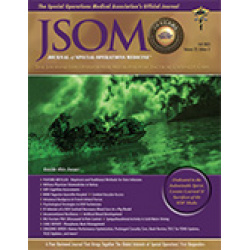Use of Intranasal Analgesia in French Armed Forces: A Cross-Sectional Survey
Montagnon R, Cungi P, Aoun O, Morand G, Desmottes J, Pasquier P, Travers S, Aigle L, Dubecq C 99(5). 0 (Journal Article)
Background: Pain management is essential in military medicine, particularly in Tactical Combat Casualty Care (TCCC) during deployments in remote and austere settings. The few previously published studies on intranasal analgesia (INA) focused only on the efficacy and onset of action of the medications used (ketamine, sufentanil, and fentanyl). Side-effects were rarely reported. The aim of our study was to evaluate the use of intranasal analgesia by French military physicians. Methods: We carried out a multicentric survey between 15 January and 14 April 2020. The survey population included all French military physicians in primary-care centers (n = 727) or emergency departments (n = 55) regardless of being stationed in mainland France or French overseas departments and territories. Results: We collected 259 responses (33% responsiveness rate), of which 201 (77.6%) physicians reported being familiar with INA. However, regarding its use, of the 256 physicians with completed surveys, only 47 (18.3%) had already administered it. Emergency medicine physicians supporting highly operational units (e.g., Special Forces) were more familiar with this route of administration and used it more frequently. Ketamine was the most common medication used (n = 32; 57.1%). Finally, 234 (90%) respondents expressed an interest in further education on INA. Conclusion: Although a majority of French military physicians who replied to the survey were familiar with INA, few used it in practice. This route of administration seems to be a promising medication for remote and austere environments. Specific training should, therefore, be recommended to spread and standardize its use.


 English
English 



